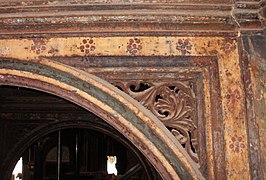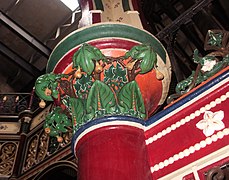
Sir Joseph William Bazalgette CB was a British civil engineer. As Chief Engineer of London's Metropolitan Board of Works, his major achievement was the creation of a sewerage system for central London which was instrumental in relieving the city of cholera epidemics, while beginning to clean the River Thames. He later designed Hammersmith Bridge.
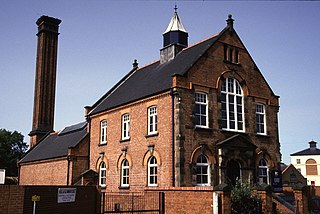
Coleham Pumping Station is a historical pumping station at Coleham in Shrewsbury, England.

The London sewer system is part of the water infrastructure serving London, England. The modern system was developed during the late 19th century, and as London has grown the system has been expanded. It is currently owned and operated by Thames Water and serves almost all of Greater London.

Abbey Mills Pumping Station is a sewage pumping station in Mill Meads, East London, operated by Thames Water. The pumping station lifts sewage from the London sewerage system into the Northern Outfall Sewer and the Lee Tunnel, which both run to Beckton Sewage Treatment Works.
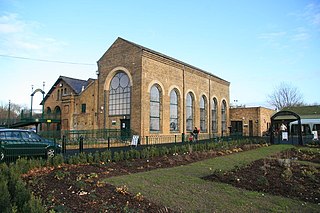
Markfield Road Pumping Station, now known as Markfield Beam Engine and Museum or sometimes just as Markfield Beam Engine is a Grade II listed building containing a 100 horsepower (75 kW) beam engine, originally built in 1886 to pump sewage from Tottenham towards the Beckton Works. The grounds of the building now form a public park known as Markfield Park. The River Moselle joins the River Lea at this location.

Claymills Pumping Station is a restored Victorian sewage pumping station on the north side of Burton upon Trent, Staffordshire, England DE13 0DA. It was designed by James Mansergh and used to pump sewage to the sewage farm at Egginton.

The Northern Outfall Sewer (NOS) is a major gravity sewer which runs from Wick Lane in Hackney to the Beckton Sewage Treatment Works in east London. Most of it was designed by Joseph Bazalgette, as a result of an outbreak of cholera in 1853 and the "Great Stink" of 1858.

The Southern Outfall Sewer is a major sewer taking sewage from the southern area of central London to Crossness in south-east London. Flows from three interceptory sewers combine at a pumping station in Deptford and then run under Greenwich, Woolwich, Plumstead and across Erith marshes. The Outfall Sewer was designed by Joseph Bazalgette after an outbreak of cholera in 1853 and "The Big Stink" of 1858. Work started on the sewer in 1860 and it was finally opened on 4 April 1865 by H.R.H. the Prince of Wales.

The Great Stink was an event in Central London during July and August 1858 in which the hot weather exacerbated the smell of untreated human waste and industrial effluent that was present on the banks of the River Thames. The problem had been mounting for some years, with an ageing and inadequate sewer system that emptied directly into the Thames. The miasma from the effluent was thought to transmit contagious diseases, and three outbreaks of cholera before the Great Stink were blamed on the ongoing problems with the river.
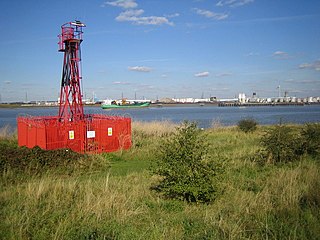
Crossness is a location in the London Borough of Bexley, close to the southern bank of the River Thames, to the east of Thamesmead, west of Belvedere and north-west of Erith. The place takes its name from Cross Ness, a specific promontory on the southern bank of the River Thames. In maritime terms, the tip of Cross Ness, in the past referred to as 'Leather Bottle Point', marks the boundary between Barking Reach and Halfway Reach. An unmanned lighthouse on Crossness is a navigational aid to shipping.
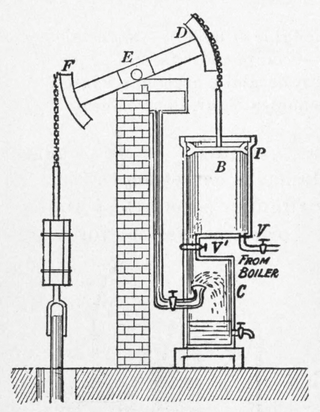
A beam engine is a type of steam engine where a pivoted overhead beam is used to apply the force from a vertical piston to a vertical connecting rod. This configuration, with the engine directly driving a pump, was first used by Thomas Newcomen around 1705 to remove water from mines in Cornwall. The efficiency of the engines was improved by engineers including James Watt, who added a separate condenser; Jonathan Hornblower and Arthur Woolf, who compounded the cylinders; and William McNaught, who devised a method of compounding an existing engine. Beam engines were first used to pump water out of mines or into canals but could be used to pump water to supplement the flow for a waterwheel powering a mill.

Papplewick Pumping Station, situated in open agricultural land approximately 3 miles (4.8 km) by road from the Nottinghamshire village of Papplewick, was built by Nottingham Corporation Water Department between 1881 and 1884 to pump water from the Bunter sandstone to provide drinking water to the City of Nottingham, in England. Two beam engines, supplied with steam by six Lancashire boilers, were housed in Gothic Revival buildings. Apart from changes to the boiler grates, the equipment remained in its original form until the station was decommissioned in 1969, when it was replaced by four submersible electric pumps.

The Ridgeway is a 3.5-mile (5.6 km) "cycling permitted pedestrian priority" footpath owned by Thames Water in southeast London. It runs between Plumstead and Crossness on an embankment that covers the Joseph Bazalgette Southern Outfall Sewer.
The Middle Harbour Syphon is a heritage-listed sewerage syphon located at Monash Crescent, Clontarf, Northern Beaches Council, New South Wales, Australia. It was designed by E. M. de Burgh, an engineer in the NSW Public Works Department and was built from 1922 to 1925 by the Department. The sewerage syphon is also known as the Middle Harbour Syphon NSOOS and The Spit Syphon. The property is owned by Sydney Water, an agency of the Government of New South Wales. The property was added to the New South Wales State Heritage Register on 15 November 2002.
The Bondi Ocean Outfall Sewer is a heritage-listed sewerage infrastructure at Blair Street, North Bondi, Sydney, Australia. The sewer line commences at the intersection of Oxford Street and College Street in Darlinghurst and then travels in a more-or-less easterly direction for 6.1 kilometres (3.8 mi) passing through a number of suburbs until it reaches Blair Street in North Bondi. It was designed and built by the Public Works Department between 1880 and 1889. It is also known as BOOS (Bondi Ocean Outfall Sewer) and Main Northern Ocean Outfall Sewer. The property is owned by Sydney Water.

The Double Bay Compressed Air Ejector Station is a heritage-listed former sewage pumping station (SPS87) and now decommissioned sewerage infrastructure in Jamberoo Lane, Double Bay, adjacent to the rear boundary of 63 William Street, in the Municipality of Woollahra local government area of New South Wales, Australia. The site of the pumping station and the State Heritage Register curtilage is shown on SHR:01324–Plan 2019, reproduced on the internet page referenced here.

The Rushcutters Bay Sewage Pumping Station is a heritage-listed sewerage pumping station located at Rushcutters Bay Park in the inner city Sydney suburb of Rushcutters Bay in the City of Sydney local government area of New South Wales, Australia. It was designed and built by the New South Wales Public Works Department from 1902 to 1904. It is also known as Sewage Pumping Station 18 and SPS 18. The property is owned by Sydney Water. It was added to the New South Wales State Heritage Register on 18 November 1999.
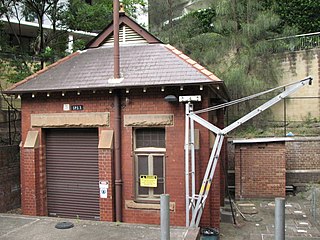
Sewage Pumping Station 3 is a heritage-listed sewerage pumping station located near 1 Booth Street, Annandale, City of Sydney, New South Wales, Australia. The building is located adjacent to Johnstons Creek. It was built from 1902 to 1904 by the New South Wales Public Works Department. It is also known as SPS 3, SP0003, Booth Street Sewage Pumping Station and Annandale Sewage Pumping Station. The property is owned by Sydney Water. It was added to the New South Wales State Heritage Register on 18 November 1999.
Greenwich Pumping Station, known until c. 1986 as Deptford Pumping Station, is a sewage pumping station in the London Borough of Greenwich built in 1865 to the east of Deptford Creek. It is part of the London sewerage system devised by Sir Joseph Bazalgette in the mid 19th century. Today operated by Thames Water, it is located on the western side of Norman Road, approximately 0.5 km (0.31 mi) south west of Greenwich town centre, on the eastern bank of Deptford Creek, around 0.5 km (0.31 mi) south of its confluence with the River Thames.
The Long Reach sewage treatment works is located in Dartford, Kent adjacent to the River Thames. It treats the sewage from a population of 837,000 in a catchment area of 518 km2 (200 sq mi) in south and south east London and west Kent. The treatment capacity of the works is 346 million litres per day (Ml/d).









